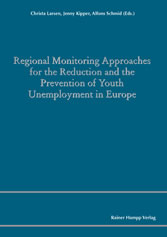Suchen und Finden
Service
Regional Monitoring Approaches for the Reduction and the Prevention of Youth Unemployment in Europe
Christa Larsen, Jenny Kipper, Alfons Schmid (Hrsg.)
Verlag Rainer Hampp Verlag, 2010
ISBN 9783866185739 , 187 Seiten
Format PDF, OL
Kopierschutz Wasserzeichen
III National Perspectives on Youth Unemployment (S. 19-20)
The Monitoring of Youth Employment and National Public Policies in France: Seven Questions for a Scoreboard
Alberto Lopez
As in many other countries, youth unemployment is a recurring concern in France. Given the current economic crisis, the employment situation has deteriorated for all persons of working age, but young entrants into the labour market are particularly affected. They are “outsiders” in a labour market which structurally favours “insiders” who tend to be older, relatively protected by their seniority within companies and by their status. This paper starts by clarifying the situation of young people in France. It goes on to characterize the responses to the problem of youth unemployment by public policy.
Based on these two elements, the paper then seeks to situate better the proposed statistical national framework that has developed since the 1970s. It strives to evaluate the impact of “training-employment assessments”, as well as the "quarterly scoreboards of youths’ work activities and employment policies”. Drawing on seven key questions, the outlook for developments in this field is examined. Finally, having looked at the national picture, the paper focuses on the role of regions and local territories.
The Situation of Young People in France
In France, workforce participants under 25 years old face a higher rate of unemployment than the rest of the working population (24.2% compared to 9.5%, in the 4th quarter 2009). This is a relatively poor performance in Europe (C. Minni 2010) and in the OECD (2009). There are many causes for this high rate of youth unemployment. As already stated, the functioning of the labour market is not very favourable to new arrivals. Furthermore, the transition from school to work is not organized with strong participation by employers in vocational training, as is the case in Germany, Denmark or Austria (Couppié, Mansuy 2004): as Grelet and Hillau (2008) have summarized well, “[y]outh transition suffers from loose coupling of the education and training system with employers”.
Lastly, the high level of unemployment among under 25 year olds also stems from the mass of school-leavers with no qualifications in this age group and the particularly harsh and persistent problems they face in getting jobs. Indeed, though young people with no qualifications account for about 16% of each cohort of school-leavers, they make up nearly 60% of the working population under 25 years old. As the OECD report has noted, the lack of a formal qualification is more penalizing in France than in most other countries.
Difficulties accessing jobs are far less marked for young people with some form of higher education: their unemployment rate after three years in working life is five to six times less than for people with no qualifications (6% versus 32% in 2007 – Joseph, Lopez, Ryk 2008). Another characteristic of the French situation faced by young beginners is that their rate of unemployment is much more sensitive to the business cycle than that of older workers. This is especially true for young people with no qualifications, who spend long periods of time on fixed-term contracts or temping. The repeated rise of youth unemployment during economic downturns undoubtedly explains one of the traits of public policy supporting youth employment, namely the cyclical nature of new measures.



